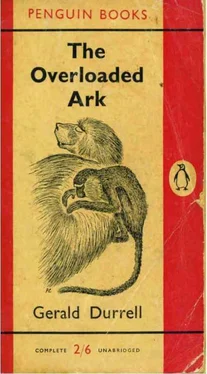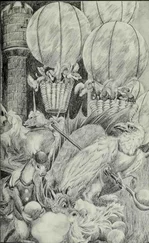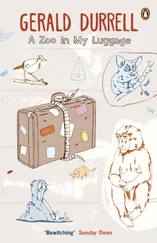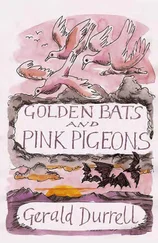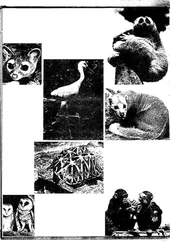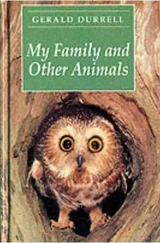I had always considered chameleons easy things to keep, but I discovered that they could be just as temperamental as a monkey or a duiker if they wanted to be. In a cage they did not seem to get enough air or sunlight. Once I placed three of them in a rather exposed position and they all promptly died of sunstroke. At last, after much experiment, I found the best way to treat them. On four saplings in the corner of the compound I had a palm-leaf roof erected, and under this, tethered by the waist with fine grass cords to branches, I kept my chameleons. They were tied about three feet apart, so they would not crawl over each other and get their ropes entangled, and in front of each one was suspended a lump of rotting meat. This attracted the flies in hundreds and the chameleons would squat there, rolling their eyes, and flipping their six-inch tongues out, and every time they would hit a fly amidships. Three times a day they had to be sprayed with water, which they did not seem to enjoy very much, but without this treatment they sickened and died.
There was a third species of chameleon in the Cameroons, and my first meeting with this rare reptile was unusual to say the least. One afternoon I had decided to attack several large termites’ nests which dotted the fields and low undergrowth which lay outside the village and within easy reach of the camp. I had gathered about twenty people to help me, as a large area around the nests had to be closed in with nets, and you needed plenty of people to patrol these and remove anything that was caught. Arriving at the first nest, a massive red earth fortress some twelve feet high and about thirty feet around the base, we commenced to clear away all the surrounding undergrowth and leave an open space round the nest. When this was done the usual selection of mysterious holes was brought to light. Round the edge of this clearing we had made, we strung the nets, and posted the excited helpers at intervals along them. Then we blocked up most of the holes in the nest and, lighting a bundle of dry grass, thrust it down a hole and stood back. Slowly the smoke drifted along the tunnels and appeared at the mouths of other holes, little coiling skeins at first which rapidly turned into great rolling clouds as more and more fuel was added. We all waited in a tense silence as we watched the smoke. A quarter of an hour passed, and not a sign of life came from the nests. I had just decided that it must be devoid of life when a great uproar started at the other side of the hill. Hurrying round I found Elias and Carpenter convulsed with laughter. Choking with mirth they pointed into the smoke, and peering I could see, at the mouth of the largest hole, a tiny chameleon, about three inches long, staggering out into the fresh air.
“Masa, we done catch big beef to-day,” roared Elias, slapping his plump thighs in an excess of mirth.
I picked the chameleon up and placed him in the palm of my hand. He was, as I say, no more than three inches long, and had a tiny stumpy little tail about an inch and a half long, which was curled up neatly like a watch-spring. On the end of his upturned nose was a small horn, which gave him a very disdainful, camel-like expression. He was a light fawn, covered with faint specks and streaks of rust red. He was my first Pygmy chameleon, and I was fascinated by his size, by his unhurried movements, and by his disdainful expression. Why he, an essentially arboreal reptile, should be found in the tunnels of a termites’ nest I could not think, but there he was. Later, when I got to know him better, I discovered other curious things about him. I never saw him eat, for example, yet he must have done so, for he stayed with me a long time and remained plump and in the best of health. I could not get him to change colour at all, either by annoying him, or by putting him on different coloured surroundings. The only time he changed was at night, when he would close his eyes and turn a delicate ash grey all over, thus looking more like a small dead leaf than ever. I eventually obtained four of these amusing little creatures, but I was never lucky enough to see one in its wild state, except the one in the termites’ nest, which I don’t think counts! Each time, when they were brought to me, I would ask the bringer where it had been caught, and each time they would say that they had captured it on the ground, generally walking solemnly along a native path. With the other chameleons they always insisted that they caught them in the trees, but the Pygmies they found on the ground. Careful questioning failed to shake them on this point. Wondering if perhaps these little reptiles were quite so exclusively arboreal as I had supposed, I made an experiment with the four I had. I placed them in a cage which had, in addition to numerous branches, a layer of earth at the bottom covered with dead leaves and bits of twigs. Hitherto they had been forced to remain in the branches because of the bareness of the cage bottom. As soon as some natural cover was available down below, they left the branches and lived entirely on the ground, hiding happily among the leaves.
The only habit they had which was exactly like their larger cousins was the dance. This is a most curious action which chameleons indulge in occasionally, and which really has to be seen to be appreciated to, the full. Place them on the ground, or on a branch, and they will stand stock still for a minute or so, only their eyes moving. Then, very slowly, they will put forward one front leg and the opposite hind leg. With these two members in mid-air they will sway rhythmically backwards and forwards for a few seconds. Then they will take the step and stand stock still again before repeating the performance with the other pair of legs. All the time their great eyes would be rolling round and round, looking up and down, back and front.
Neither the Africans nor my collection of monkeys appreciated the chameleons. The Africans would have nothing to do with them, alive or dead, and the sight of my handling and being bitten by these reptiles would set them all off moaning and clicking their fingers in agitation. They considered that every chameleon was deadly poisonous, and no argument would convince them otherwise. The monkeys made it quite obvious that they disliked and feared these reptiles, but not in the same way as they feared a snake. The chameleons fascinated them and revolted them at the same time. The monkeys were tethered to stakes next door to the shelter that housed the chameleons, and they never tired of watching the reptiles moving slowly about their branches. Whenever a chameleon would shoot out his tongue for a fly, all the monkeys would start back as though bitten, and utter sharp cries of wonder and interest.
At this time my monkey collection consisted of a Red-eared Guenon, four Putty-nose Guenons, and
six Drills, and one day I tried an experiment. One of the chameleons had died, and so I took the corpse to the monkeys, and sitting down among them I showed it to them. They formed a respectful circle round me and examined the chameleon with interest. After screwing up his courage the eldest Drill touched it quickly, then drew back his hand and wiped it hastily on the ground. I could not persuade the Guenons to come anywhere near it. The Drills eventually became very brave and started to play with the corpse, even chasing the screaming Guenons with it and threatening them. I had to put a stop to this as the Drills were quite bad-mannered enough, and the Guenons were protesting bitterly, and seemed genuinely terrified. Then I tried something else: I got a large live chameleon and let it walk amongst the monkeys. Although they kept out of its way and chattered and made faces at it, they did not seem more than slightly afraid. I then got a fair-sized water-snake and released that. There was no mistaking the fear this time: they all fled to the top of their stakes and clung there screaming blue murder until I had removed the snake.
Читать дальше
